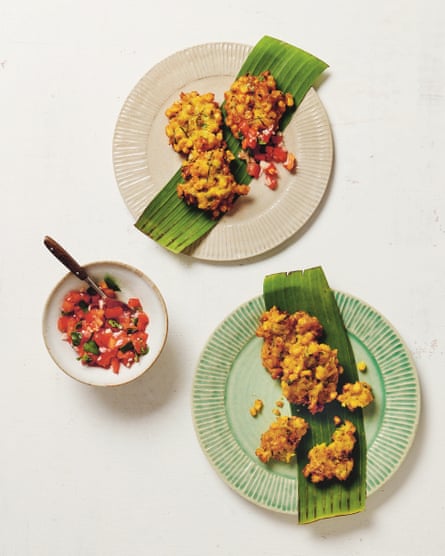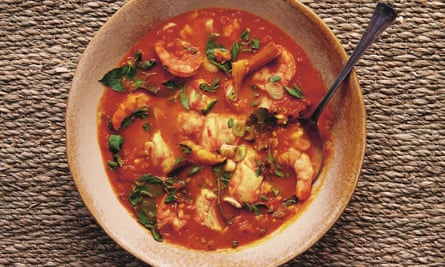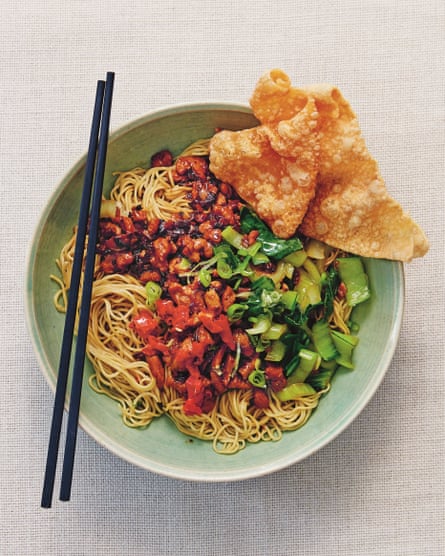
It has been more than four decades since I left the city, yet I still think of Manado, in North Sulawesi, Indonesia, as my home. Those precious early food experiences have had a powerful impact not only on the way I cook but also on my whole approach to food – and the catalyst was my maternal grandmother, Oma. How I miss her.
I can see it all now. My grandfather’s verdant coconut plantations set against postcard-worthy volcanic mountains. Pristine beaches skirting coral reefs teeming with marine life. It’s a view that triggers memories of the food of my childhood, from mouth-watering candied nutmeg (manisan pala) to breakfasts of banana fritters served alongside slices of soft white bread and chocolate sprinkles (meises).
Tropical seas surround Manado, so naturally one of my favourite foods is fish. We love to barbecue and serve it with dabu-dabu, a relish of fresh tomatoes, shallots, chillies, calamansi and mint. This and many other Manadonese recipes are a world away from the most ubiquitous Indonesian dishes such as chicken satay, nasi goreng and beef rendang.
The pleasures of early childhood were interrupted by a move to the capital city. In Jakarta, I discovered new dishes and drinks such as tempeh, gado-gado and nasi uduk, the steamed rice dish from the Betawis (an Austronesian ethnic group indigenous to Jakarta and its outskirts).
My school friends and I would sit on coloured plastic stools, chatting and laughing over steaming bowls of Jakartan chicken noodles, siomay dumplings or rice noodle soup with meatballs.
Being in Indonesia’s capital – the centre of culture, economy and politics of thousands of islands – provided me with a knowledge of regional Indonesian cuisine and a deeper understanding and appreciation of diversity. Each island and region is defined by its unique cuisine, history, culture, art, language and identity.
We are in total unison on one subject: we believe Indonesian food is the best.
Perkedel jagung dan dabu-dabu (sweetcorn fritters with chilli and tomato sambal)
Origin: Sulawesi
Served as a snack or as part of a meal, these sweet and crunchy fritters are absolutely irresistible. Best of all, they’re unbelievably simple to make.
Traditionally, the fritters are made with fresh sweetcorn on the cob but you can substitute canned (or frozen) sweetcorn so long as you drain out all the water. (This ensures a crunchy fritter.)

Prep 15 mins
Cook 10-20 mins
Serves 4
250g sweetcorn kernels (1½ cups)
3 makrut lime leaves, centre stem removed and thinly sliced
2 cloves garlic, grated
2 spring onions, finely chopped
1–2 red bird’s eye chillies, finely chopped
1 banana shallot, finely chopped
6 tbsp rice flour
4 tbsp cornflour
½ tsp salt
½ tsp white pepper, crushed
500ml sunflower oil (generous 2 cups), for deep-frying
Dabu-dabu (chilli and tomato sambal), to serve, recipe below
If using canned sweetcorn, drain well and squeeze out as much water as possible from the kernels. Transfer the sweetcorn to a food processor and blend for 10 seconds until a coarse puree.
In a large bowl, combine the sweetcorn, lime leaves, garlic, spring onions, chillies and shallot and mix well. Stir in the rice flour and cornflour. Season with salt and pepper. The batter should be thick but easy to mix. If needed, add two to three tablespoons of cold water to thin it out slightly.
Heat the oil in a wok or deep saucepan over medium heat. The oil is ready when a cube of bread dropped in sizzles on contact and turns golden in 10 to 15 seconds. (Alternatively, use a thermometer and heat to 180C.)
Scoop a tablespoon of the mixture and flatten it slightly into a patty. Repeat with the remaining mixture. Carefully lower five or six fritters into the pan and deep-fry for two to three minutes on each side until golden brown. Using a slotted spoon, transfer the cooked fritters to a plate lined with paper towels. Repeat with the remaining fritters.
Place the fritters on a serving dish and serve with the sambal.
Dabu-dabu (chilli and tomato sambal)
This spicy sambal is vibrant, refreshing and very versatile. Unripe green tomatoes are traditionally used, but regular tomatoes are an acceptable substitute. The sambal can be prepared in advance but to preserve the freshness of the tomatoes, add the lime juice, salt and oil just before serving.
Serves 4
3 green or red tomatoes, chopped
2-3 red bird’s eye chillies, thinly sliced
1 banana shallot, finely chopped
2 tbsp coconut oil or extra virgin olive oil, warmed
¼ tsp salt
Pinch sugar (optional)
Juice of 2 limes
Place all the ingredients in a bowl and mix well. Serve immediately, or transfer to an airtight container, top with extra oil and store in the refrigerator for two to three days.
Seafood waku blanga (spicy seafood stew with tomato and lemongrass)
Origin: Sulawesi
Woku is a blend of spices and herbs unique to the cuisine of Manado. It is a spicy turmeric paste enhanced with lemongrass, makrut lime leaves, spring onions, tomato and basil.
The Manadonese prepare this dish with chunky pieces of fish in a wok (blanga), but I have opted for fish fillet and prawns in this recipe. (The sauce makes the perfect foil for rice or pasta.)
I use good-quality canned San Marzano tomatoes, but you could replace this with two chopped tomatoes and double the amount of water for a traditional preparation.

Prep 15 mins
Cook 20 mins
Serves 4
2 tbsp sunflower oil
1 quantity bumbu kuning (yellow spice paste), recipe below
2 lemongrass stalks, crushed and tied into a knot
4 spring onions, sliced
4 makrut lime leaves, torn
1 x 400g tin chopped tomatoes
1 bunch basil
1 pandan leaf, tied into a knot (optional)
1 turmeric leaf (optional)
2 x 500g skinless cod fillets, cut into bite-size pieces
250g tiger prawns, peeled and deveined
2 tbsp lime juice
Steamed rice or cooked pasta, to serve
Heat the oil in a large, heavy frying pan over medium heat. Add the bumbu kuning and cook for five to six minutes until fragrant. Add the lemongrass, spring onions, lime leaves, tomatoes, half of the basil, and the pandan and turmeric leaves, if using. Mix well.
Pour in 100ml (scant ½ cup) of water and bring to a boil. Reduce the heat to medium low, cover and simmer for 10 minutes, stirring occasionally. Season.
Season the fish and prawns with salt and lime juice, then add to the pan. Cover and simmer for two to three minutes, until the fish is just cooked through. Add the remaining basil. Season to taste with more salt and lime juice if needed. Discard the lemongrass and lime leaves. Serve with rice or pasta.
Bumbu kuning (yellow spice paste)
Turmeric will change the flavour and colour of white and red basic pastes. You can create a mild yellow spice paste by omitting the chillies entirely, but it won’t have the same impactful flavour or colour.
Makes 115g (generous ½ cup)
For the bumbu putih (white spice paste)
2 candlenuts or macadamia nuts, coarsely ground (optional)
2-3 tbsp coconut oil or sunflower oil
4 cloves garlic, sliced
2-3 small banana shallots, sliced
20g ginger, sliced
10g galangal, sliced
For the bumbu kuning
4-6 red bird’s eye chillies, coarsely chopped
2 large red chillies, coarsely chopped
15g fresh turmeric, or 1-2 tsp ground turmeric
To make the bumbu putih (white spice paste): If using the candlenuts, heat a frying pan over medium-low heat. Add the candlenuts and dry-roast for three to four minutes. Transfer to a plate.
Combine all the bumbu putih ingredients in a small blender and blend into a smooth paste.
To make the bumbu kuning (yellow spice paste): Combine the completed bumbu putih and the bumbu kuning ingredients in a small blender and blend into a smooth paste.
Mie ayam Jakarta (Jakartan chicken noodles)
Origin: Java

Enjoyed any time of the day – breakfast, lunch or dinner – this dish is served on every street corner of Jakarta (hence its name). It’s prepared on the spot by the food vendor, an individual experience for each customer and an enjoyable ritual.
It tastes even better when the chicken mixture is prepared a day earlier. For added texture, consider a garnish of deep-fried wonton skins (pangsit goreng).
Prep 30 mins
Cook 35 mins
Serves 4
For the garlic oil
100ml vegetable oil (scant ½ cup)
6 cloves garlic, finely chopped
For the chicken and mushrooms
3 tbsp sunflower oil
2 large chicken breasts, cut into 5mm cubes
Salt and white pepper, to taste
1 banana shallot, thinly sliced
4 cloves garlic, finely chopped
100g straw or button mushrooms, quartered
3 makrut lime leaves, torn
2 salam leaves, or substitute with bay leaves
1 stalk lemongrass, crushed and tied into a knot
10g galangal, finely grated
100ml chicken stock (scant ½ cup)
5 tbsp sweet soy sauce
2 tbsp light soy sauce
For the wonton crisps
300ml sunflower oil (1¼ cups)
8 wonton skins, each cut into triangles
For the noodles
400g fresh egg noodles (or 300g dried noodles)
2 large bok choy, cut into 1cm-thick slices
4 tsp light soy sauce
To serve
2 tbsp spring onions, finely chopped
Vinegar sambal (optional)
To make the garlic oil: Combine the oil and garlic in a frying pan and saute for five minutes over medium-low heat. Season with salt and let cool.
To prepare the chicken and mushrooms: Heat two tablespoons of oil in a frying pan or wok over medium-high heat. Add the chicken, season with salt and saute for six to seven minutes until slightly golden. Transfer to a plate.
Heat the remaining oil in the same frying pan over medium heat. Add the shallot and garlic and saute for three to four minutes. Add the mushrooms, lime leaves, salam leaves (or bay leaves), lemongrass and galangal and saute for five minutes or until the mushrooms have softened.
Return the chicken to the pan. Add the stock and both soy sauces and cook for another 10 minutes over low heat. Season with salt and pepper. Set aside. Remove the lemongrass and the lime and salam leaves.
To make the wonton crisps: Heat the oil in a small saucepan over medium heat. The oil is ready when a cube of bread dropped in sizzles on contact and turns golden in 10 to 15 seconds. (Alternatively, use a thermometer and heat to 180C.)

Add the wonton skins and deep-fry for one to two minutes until golden brown. Using a slotted spoon, transfer the wonton skins to a plate lined with paper towels to drain.
To cook the noodles: Bring a large saucepan of water to a boil. Add fresh noodles to the pan and cook for one minute. Drain, reserving the cooking water. (If using dried noodles, prepare according to the package directions.)
To assemble: Cook the bok choy for 30 seconds in the reserved hot noodle water, then drain.
In a large bowl, combine the noodles, four teaspoons of the garlic oil and soy sauce and mix. Divide among the serving bowls. Top each with chicken, mushrooms and bok choy. Garnish with spring onions. Add one or two wonton crisps and serve with sambal, if you wish.



